It has been more than six months since Boris Johnson made the historic announcement he was putting the UK into lockdown – a plan that would have been unthinkable just months before.
In the following weeks, the country was battered by the force of the Covid-19 virus – daily reports of new cases topped 5,000, while the deaths of more than 1,000 people were reported in a single day in April.
Day after day, the agenda was completely ruled by the status of the pandemic and the UK became a nation of amateur epidemiologists.
Since then, the effects of the pandemic have subsided – as spring turned into summer, the number of people dying with the virus began to drop, as did the number of people diagnosed with Covid-19 in the first place.
But as the all-dominating, headline-grabbing nature of the pandemic has waned, so too has the flow of information about its grip and extent.
The urgent daily conferences from No.10 have stopped and and the Department of Health and Social Care no longer tweets the number of people dying with the virus each day.
So – how badly is Covid-19 affecting the UK now, compared to the peak of the pandemic?
And, with experts suggesting there could be a second surge in the virus over the winter, where is the country heading?
The number of people dying with Covid-19 has fallen dramatically
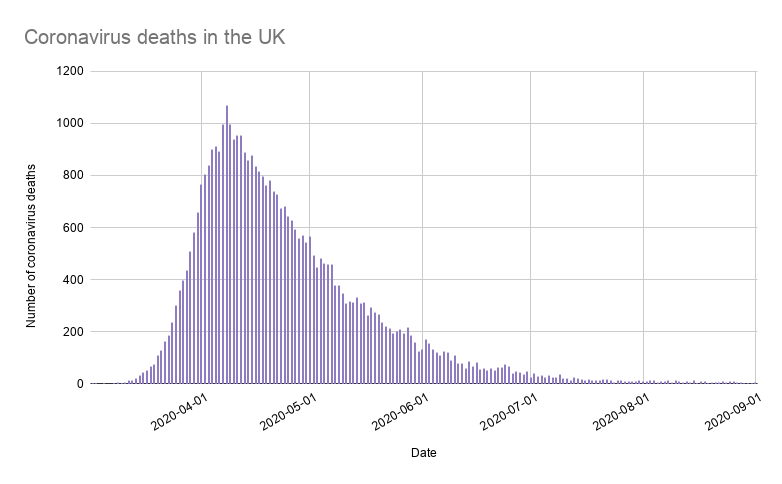
As of September 6, the UK has seen the deaths of 41,551 people who had tested positive for Covid-19 within the last four weeks of their lives. It means the country has the fifth most coronavirus fatalities in the world.
At the peak of the coronavirus crisis, the deaths of several hundred people were being announced each day. On April 8, 1,072 people died – the highest figure during the pandemic and the only time the number has surpassed 1,000.
Since April, there has been a dramatic dive in the number of people in the UK dying with coronavirus and the number of daily deaths has remained below 100 since June 11.
In August, daily deaths did not creep above 16. While the number has yet to hit 0, just two deaths were recorded on September 6.
Data shows coronavirus cases have dropped since April – but are starting to rise again
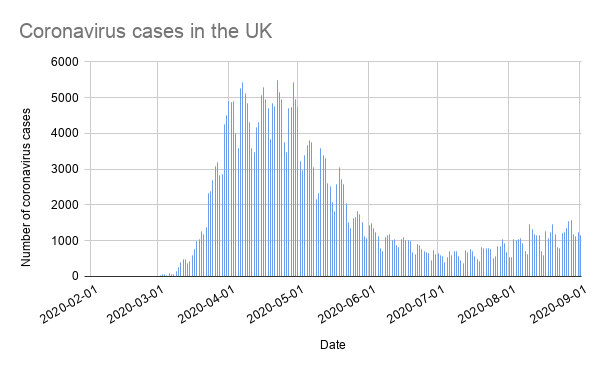
As of September 6, the UK had recorded 347,152 coronavirus cases. However, there are two ways of tracking coronavirus cases – by the specimen date, or the date the case was reported.
Recording cases by ‘specimen date’ means a positive case is counted on the day someone with the virus is given a Covid-19 test.
On the day the prime minister announced the UK lockdown on March 23, more than 2,300 people with Covid-19 were tested for the disease.
Over the following four weeks, cases climbed rapidly, remaining above 3,400 throughout April. Covid-19 cases peaked on April 22, when 5,490 people with the virus were given a test.
The start of May brought a gradual but continuous fall in cases – between June 19 and July 28, daily cases remained below 1,000. On July 12, the UK recorded just 367 new coronavirus cases – the lowest since March 14.
But since the start of August, there has been a creeping rise in positive coronavirus tests – cases surpassed the 1,000 mark on 22 days in August.
The highest number of cases recorded in the month was on August 28, when specimens were taken from 1,585 people with the virus. On September 1, this figure rose to 1,720.
Another set of stats show a “concerning” spike in cases
The second way of presenting Covid-19 stats is by the date the case was first recorded in the government’s data.
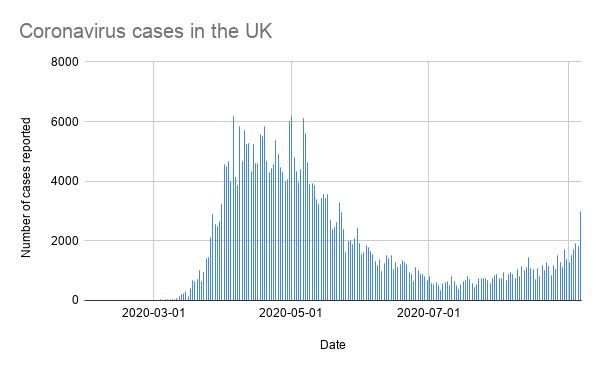
On April 5, a total of 6,199 new coronavirus cases were reported for the first time – the highest throughout the entire pandemic in the UK.
While the number of new cases remained high throughout April, it fell throughout May and June, reaching a low of 352 on July 6.
However, on September 6 these statistics caused alarm when 2,988 new cases were recorded – the highest figure in more than three months.
The last time the daily increase in new coronavirus cases neared 3,000 was May 22, when the positive coronavirus tests of another 2,959 people were reported.
Health secretary Matt Hancock said the government was “concerned” about the spike in cases, but said they were predominantly among young people – rather than at-risk elderly people.
“But of course young people can pass on the disease to their grandparents and we don’t want to see that,” he said, urging people to maintain social distancing.
One key difference between the number of cases in May and September is the number of deaths recorded.
While there was a sharp increase in the number of reported cases on September 6, the number of people dying in the UK remained low. The deaths of two people with Covid-19 were reported in the UK on the same day.
In comparison, on May 23 the deaths of 222 coronavirus patients were recorded.
It’s important to remember that testing has also increased
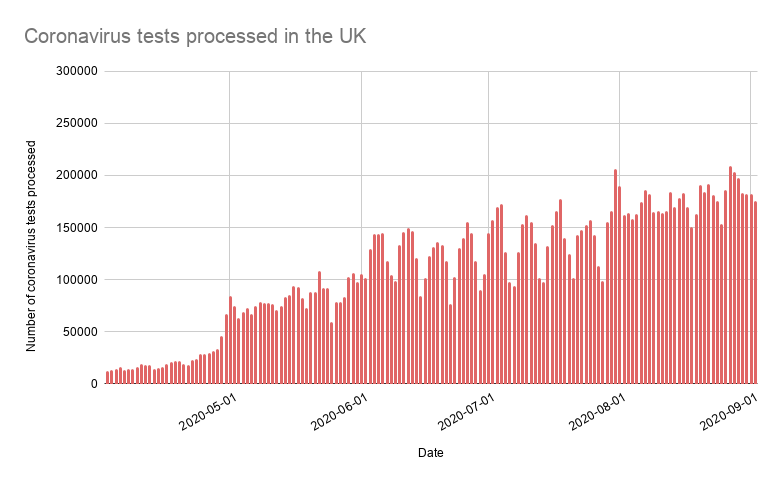
The UK’s ability to test people for coronavirus has grown hugely during the pandemic – on April 22, at the peak of the crisis, just 22,814 tests were carried out.
In comparison, 208,835 people were tested on August 27 – a near tenfold increase.
So is the recent increase in positive cases down to more testing? A rough way of trying to work this out is by calculating the percentage of positive tests over recent weeks.
Between July 1 and September 1, the percentage of positive tests (calculated using positive tests by specimen date) remained below 1%, ranging from a low of 0.23% to a high of 0.89%.
But there were day-to-day fluctuations and no obvious upward trend across the dates.
However, Matt Hancock did brand the spike in cases reported on September 6 a “concern”, urging people to maintain social distancing to avoid passing on the disease.
There’s been a big dip in the number of coronavirus patients in hospital
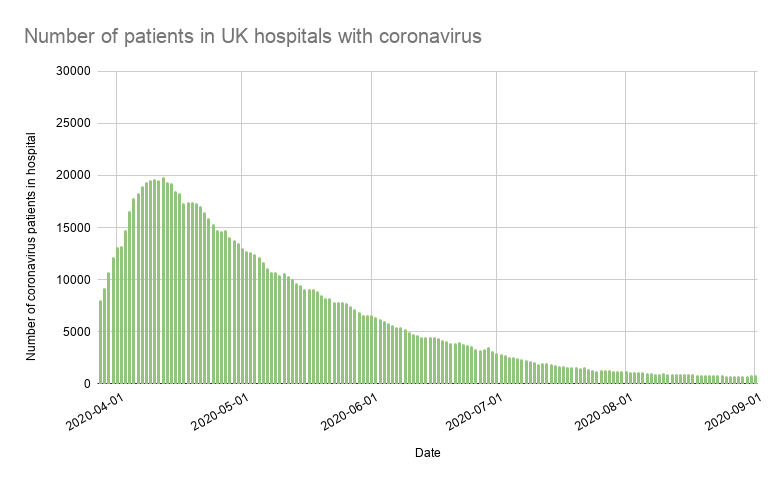
In line with Covid-19 deaths in the UK, the number of people in hospital with coronavirus has dropped dramatically in recent months, following a spike in April.
On April 12 at the height of the crisis, there were 19,872 coronavirus patients in hospital in the UK. By September 2, this had dropped to 743 – the lowest since March.
Fewer and fewer people are on ventilators
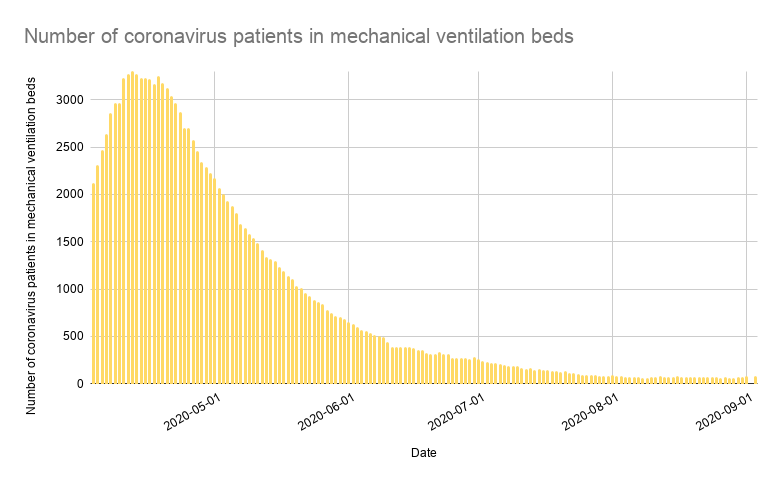
Similarly, the number of coronavirus patients requiring ventilation has fallen significantly over the past six months.
Down from a peak of 3,301 people in the UK in mechanical ventilation beds on April 12, there were just 60 on August 28.
On September 4 – the most recent data available – 69 coronavirus patients were in these ventilation beds.
Will there be a second peak over the winter?
There have been widespread fears that there could be a second spike in coronavirus cases over the winter.
Last week, a leaked report from Sage – the group of scientists which advises the government – warned there could be 85,000 deaths across the UK this winter due to Covid-19 in a “reasonable worst case scenario”.
Seen by the BBC, the document was based on the assumptions that schools would remain open, while the government’s tracing, isolation and quarantine measures would only be 40% effective in cutting the spread of coronavirus outside households.
Responding to the leaked report, a spokesperson for the government said it was planning for a range of scenarios, “including the reasonable worst case scenario”.
“Our planning is not a forecast or prediction of what will happen,” they said. “It reflects a responsible government ensuring we are ready for all eventualities.”
So why are scientists – and ministers – worried there could be another surge in coronavirus cases over the winter?

Professor David Alexander, an expert in emergency planning, pandemics and practical epidemiology from UCL, told HuffPost UK that there was unlikely to be a solely weather-related increase in Covid-19 cases, with the virus less seasonal than scientists first thought at the start of the pandemic.
“It’s not merely a question of how a disease behaves in winter,” he explained. “If it were, the whole thing would be relatively simple.
“However, I think we probably will see a rise over the winter – whether you would classify that as a full scale second wave is hard to tell at present,” Alexander said.
“I think the main reason there might be an increase in epidemiological and medical terms is not so much that the disease is stimulated by winter conditions, but that immunity tends to fall generally in the winter.”
Any kind of increase would also be influenced by the public’s behaviour, as well as the effectiveness of measures implemented by the government to try and tackle the spread of the virus.
“It’s quite clear that the way people behave has a considerable impact on the spread of the disease,” Alexander added. “One thing people don’t understand about coronavirus at the moment is that the spread is exponential.”
That means it wouldn’t take much to set off a new peak. If one person with coronavirus does not follow self-isolation rules, or people fail to wear a mask when required, they could trigger a rapid chain of infection, he explained.
The R-rate is rising – very slowly
Throughout the Covid-19 pandemic, the reproduction – or R – rate of the virus has been seen as a key indicator of how the disease is spreading.
The R number is important – if it’s above 1, it means the epidemic growing, with each coronavirus patient infecting more than one person. If it’s below 1, the epidemic is said to be shrinking.
It has been estimated that in March – before lockdown restrictions were imposed – the R-rate was as high as 4.
Since then, there has been a steep decline in the reproduction rate of the virus, thanks in part to social-distancing, working from home and people wearing masks in public places.
On May 22, when the government first published the R number, it was between 0.7 and 1.0.
It then dropped below 1.0 on May 29 – and remained there until August 7.
However, since then the R rate has hovered around the 1.0 mark – suggesting coronavirus infections could be growing once again.
According to the latest government data, the R rate in the UK is currently between 0.9 and 1.1, with a growth rate of between -2% and +1.
That means the number of new infections is somewhere between shrinking by 2% and growing by 1% every day.
There is some daily variation in the government’s statistics as the figures are adjusted to reflect updated reports. The figures in this article are correct as of September 6, according to government data.
